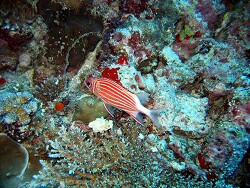Info
The Crowned Squirrelfish has a conspicuous silvery-white stripe along the body, a white vertical stripe on the gill cover, a similar oblique white stripe below the eye, a reddish-black to black dorsal fin with two white stripes, and a whitish spot on the upper part of the caudal peduncle.
The Crowned Squirrelfishfeeds at night on invertebrates such as polychaetes, small crustaceans, and mollusks.
Small groups of drert hussars inhabit shallow coral reefs, lagoons, and seaward reefs where they hide in crevices and under ledges during the day and feed on invertebrates on open sandy areasv at night.
Synonyms:
Adioryx diadema (Lacepède, 1802)
Holocentre diadème Commerson & Lacepède, 1801
Holocentrum diadema Lacepède, 1802
Holocentrus diadema Lacepède, 1802
Sargocentrum diadema (Lacepède, 1802)







 Jean-Marie Gradot, La Reunion
Jean-Marie Gradot, La Reunion




























